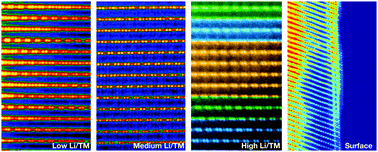当前位置:
X-MOL 学术
›
Energy Environ. Sci.
›
论文详情
Our official English website, www.x-mol.net, welcomes your
feedback! (Note: you will need to create a separate account there.)
Effect of composition on the structure of lithium- and manganese-rich transition metal oxides†
Energy & Environmental Science ( IF 32.4 ) Pub Date : 2018-01-10 00:00:00 , DOI: 10.1039/c7ee02443f Alpesh Khushalchand Shukla 1, 2, 3, 4, 5 , Quentin M. Ramasse 5, 6, 7 , Colin Ophus 2, 3, 4, 8, 9 , Despoina Maria Kepaptsoglou 5, 6, 7 , Fredrik S. Hage 5, 6, 7 , Christoph Gammer 10, 11, 12, 13 , Charles Bowling 4, 14, 15 , Pedro Alejandro Hernández Gallegos 4, 14, 15 , Subramanian Venkatachalam 4, 14, 15
Energy & Environmental Science ( IF 32.4 ) Pub Date : 2018-01-10 00:00:00 , DOI: 10.1039/c7ee02443f Alpesh Khushalchand Shukla 1, 2, 3, 4, 5 , Quentin M. Ramasse 5, 6, 7 , Colin Ophus 2, 3, 4, 8, 9 , Despoina Maria Kepaptsoglou 5, 6, 7 , Fredrik S. Hage 5, 6, 7 , Christoph Gammer 10, 11, 12, 13 , Charles Bowling 4, 14, 15 , Pedro Alejandro Hernández Gallegos 4, 14, 15 , Subramanian Venkatachalam 4, 14, 15
Affiliation

|
The choice of chemical composition of lithium- and manganese-rich transition metal oxides used as cathode materials in lithium-ion batteries can significantly impact their long-term viability as storage solutions for clean energy automotive applications. Their structure has been widely debated: conflicting conclusions drawn from individual studies often considering different compositions have made it challenging to reach a consensus and inform future research. Here, complementary electron microscopy techniques over a wide range of length scales reveal the effect of lithium-to-transition metal-ratio on the surface and bulk structure of these materials. We found that decreasing the lithium-to-transition metal-ratio resulted in a significant change in terms of order and atomic-level local composition in the bulk of these cathode materials. However, throughout the composition range studied, the materials consisted solely of a monoclinic phase, with lower lithium content materials showing more chemical ordering defects. In contrast, the spinel-structured surface present on specific crystallographic facets exhibited no noticeable structural change when varying the ratio of lithium to transition metal. The structural observations from this study warrant a reexamination of commonly assumed models linking poor electrochemical performance with bulk and surface structure.
中文翻译:

组成对富含锂和锰的过渡金属氧化物的结构的影响†
在锂离子电池中用作阴极材料的富含锂和锰的过渡金属氧化物的化学组成的选择,会严重影响其作为清洁能源汽车应用存储解决方案的长期生存能力。它们的结构已被广泛辩论:从个别研究中得出的相互矛盾的结论往往考虑到不同的构成,这使人们难以达成共识并为未来的研究提供信息。在这里,在广泛的长度范围内的互补电子显微镜技术揭示了锂与过渡金属之比对这些材料的表面和整体结构的影响。我们发现,降低锂与过渡金属之比会导致这些阴极材料的主体在有序和原子级局部组成方面发生重大变化。然而,在研究的整个组成范围内,材料仅由单斜晶相组成,锂含量较低的材料显示出更多的化学有序缺陷。相反,当改变锂与过渡金属的比例时,存在于特定晶体学刻面上的尖晶石结构的表面没有显示出明显的结构变化。这项研究的结构观察结果值得重新检验通常假定的模型,这些模型将不良的电化学性能与体积和表面结构联系在一起。当改变锂与过渡金属的比例时,存在于特定晶体学刻面上的尖晶石结构表面没有表现出明显的结构变化。这项研究的结构观察结果值得重新检验通常假定的模型,这些模型将不良的电化学性能与体积和表面结构联系在一起。当改变锂与过渡金属的比例时,存在于特定晶体学刻面上的尖晶石结构表面没有表现出明显的结构变化。这项研究的结构观察结果值得重新检验通常假定的模型,这些模型将不良的电化学性能与体积和表面结构联系在一起。
更新日期:2018-01-10
中文翻译:

组成对富含锂和锰的过渡金属氧化物的结构的影响†
在锂离子电池中用作阴极材料的富含锂和锰的过渡金属氧化物的化学组成的选择,会严重影响其作为清洁能源汽车应用存储解决方案的长期生存能力。它们的结构已被广泛辩论:从个别研究中得出的相互矛盾的结论往往考虑到不同的构成,这使人们难以达成共识并为未来的研究提供信息。在这里,在广泛的长度范围内的互补电子显微镜技术揭示了锂与过渡金属之比对这些材料的表面和整体结构的影响。我们发现,降低锂与过渡金属之比会导致这些阴极材料的主体在有序和原子级局部组成方面发生重大变化。然而,在研究的整个组成范围内,材料仅由单斜晶相组成,锂含量较低的材料显示出更多的化学有序缺陷。相反,当改变锂与过渡金属的比例时,存在于特定晶体学刻面上的尖晶石结构的表面没有显示出明显的结构变化。这项研究的结构观察结果值得重新检验通常假定的模型,这些模型将不良的电化学性能与体积和表面结构联系在一起。当改变锂与过渡金属的比例时,存在于特定晶体学刻面上的尖晶石结构表面没有表现出明显的结构变化。这项研究的结构观察结果值得重新检验通常假定的模型,这些模型将不良的电化学性能与体积和表面结构联系在一起。当改变锂与过渡金属的比例时,存在于特定晶体学刻面上的尖晶石结构表面没有表现出明显的结构变化。这项研究的结构观察结果值得重新检验通常假定的模型,这些模型将不良的电化学性能与体积和表面结构联系在一起。











































 京公网安备 11010802027423号
京公网安备 11010802027423号